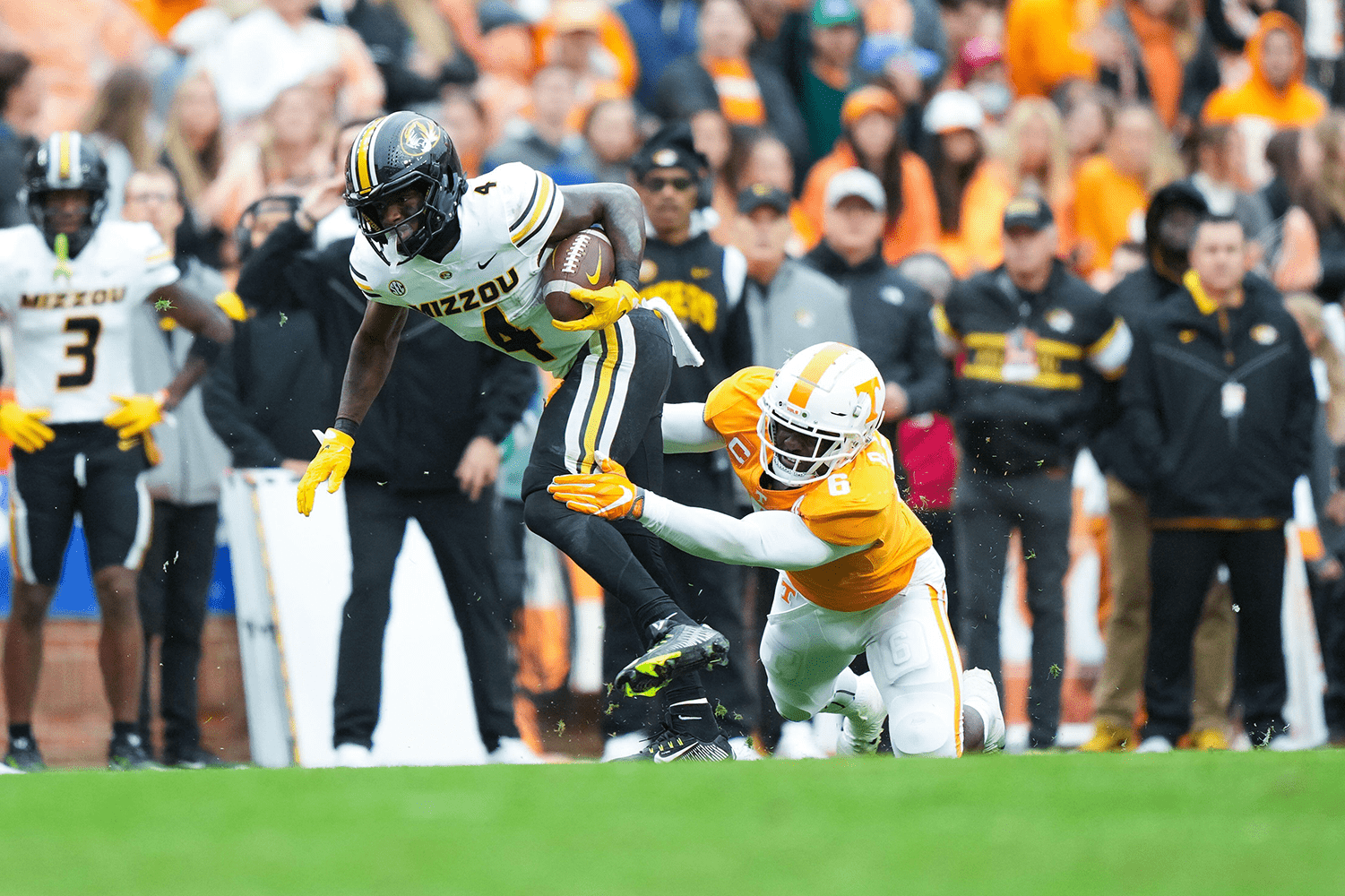NOTE: Following Hudl’s acquisition of Statsbomb, its football platform is now called Hudl IQ. Learn more about the acquisition here.
The long-accepted way to display baseline tackling stats in football has generally been to sort by total tackles, summing each player’s solo tackles and assisted tackles. For instance, if one were to evaluate player tackling data across any of espn.com, cfbstats.com, or stats.ncaa.org, any of these resources will show Jason Henderson of Old Dominion as the nation’s leading tackler with 186 total tackles last season – 39 more than #2 on the list, Shaun Dolac of Buffalo.
In this case, the raw number of 186 total tackles for Henderson ignores the fact that 128 of his 186 tackles were assisted tackles, meaning only 58 of these 186 tackles (31%) were instances in which Henderson got the ball carrier down to the ground on his own. This is important context when considering that solo tackles and assisted tackles are weighted equally as far as total tackles are concerned – an obvious shortcoming of the metric. By comparison, Dolac led the nation with 97 solo tackles, 15 more than #2 on the list, equating to 66% of his total tackles being recorded as solo tackles, far more than Henderson.
As the football world has grown more data-driven and analytical in thought, there has been little development to baseline tackling metrics since the simple concept of tackle % was introduced, which is the % of a player’s defensive plays in which he records a tackle, solo or assisted. This is a better representation of effective tackling than raw total tackles, baking in the simple nuance of rate-based metrics to account for varying opportunities among players to make tackles, but this does not address the consideration of solo versus assisted tackles. That’s where True Tackle % comes into play.
True Tackles and True Tackle %
To combat the issue of raw Tackle % not differentiating solo from assisted tackles, Hudl IQ has created the metrics of True Tackles and True Tackle %, which is the same measure as raw Tackle % with the simple adjustment of only crediting players with ½ of a tackle for each assisted tackle. Given that True Tackles on the player level will sum to the actual number of tackles made on the team level, unlike Total Tackles, True Tackle % is a very intuitive name for this metric since the sum of Total Tackles on the player level will always surpass the “true” number of team tackles made.
To illustrate the impact of True Tackle % compared to traditional Tackle %, Hudl IQ compared these metrics among all defenders ranked within the Top 200 overall in this year’s NFL Draft class according to Scouts Inc. This analysis was limited to players with at least 150 collected plays within the Hudl IQ database, which covered 97 of the 102 defenders ranked within the Scouts Inc. Top 200 overall prospects heading into this year’s NFL Draft.
Throughout this analysis, we will separate players by the 3 basic levels of defense (DL, LB, DB) to group players with others who are likely to have a similar volume and types of tackle attempts.
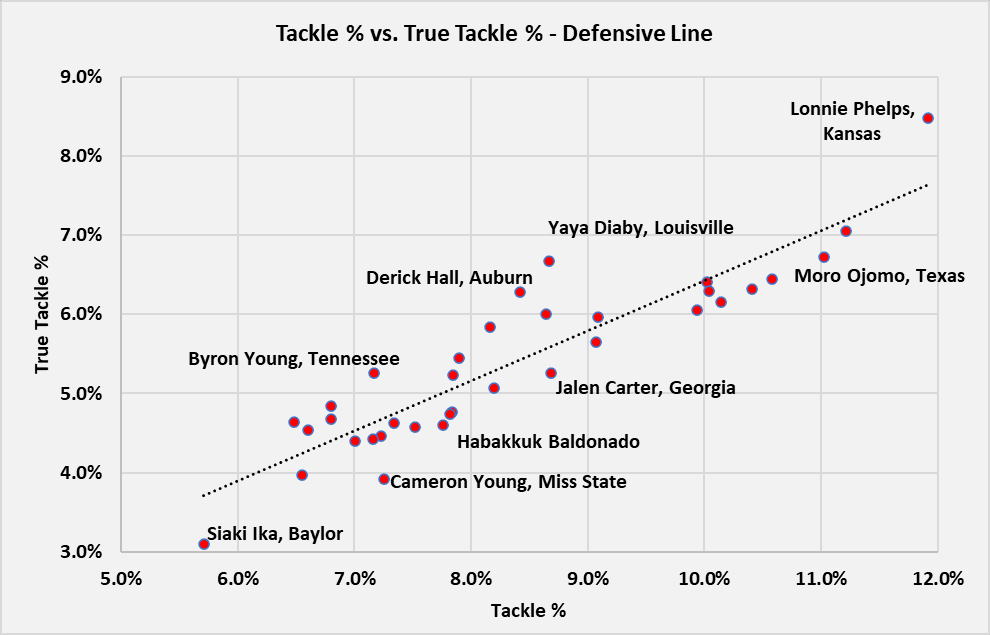
The players above the trendline (Byron Young, Derick Hall, Yaya Diaby, and Lonnie Phelps) are examples of players who would be underlooked by basic Tackle % given the high ratio of their tackles made that were solo tackles, which we infer to be more difficult to convert than assisted tackles.
On the contrary, those below the trendline, including the widely talked about Jalen Carter, are players who generated a higher percentage of their total tackles through assisted tackles compared to the average defensive lineman plotted on the chart. Cameron Young of Mississippi State and Siaki Ika of Baylor are the two defensive linemen in particular that stand out as having made relatively more assisted than solo tackles.
Below are the same charts for Linebackers and Defensive Backs.
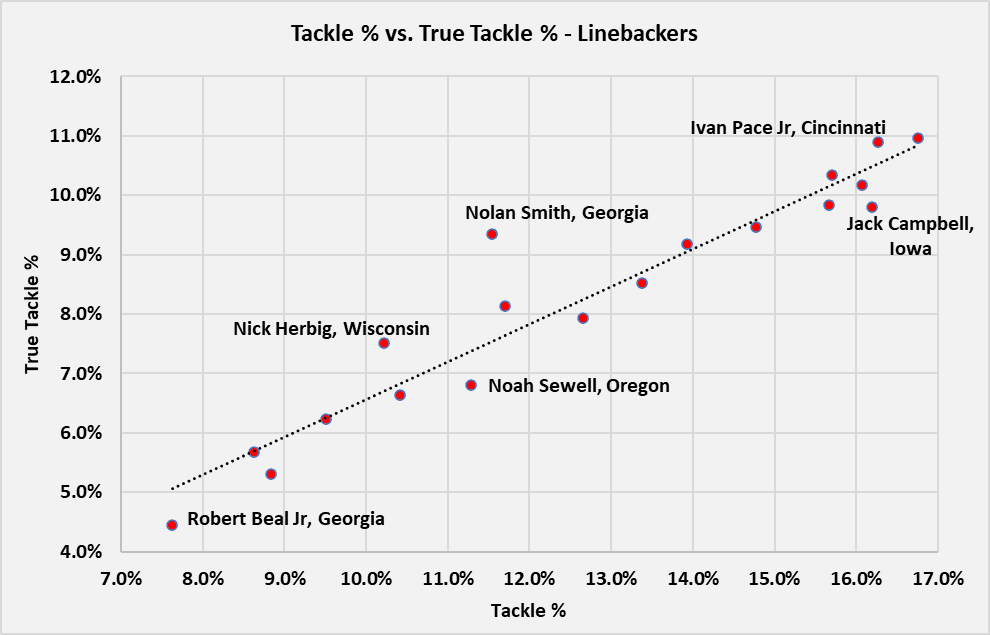
Of note is Georgia standout Nolan Smith, who projects to be a firm 1st round pick. While only playing 182 snaps last season, fewest of any player included in the analysis, Smith made the most of his time on the field, showing furthest above the trendline among rostered LBs ranked within the Scouts Inc. top 200. It’s worth noting that Hudl IQ tracks Smith recording a defensive line technique in 151 of his snaps (83%), and his 9.3% True Tackle % would have led all defensive linemen, albeit over his smaller sample of plays.
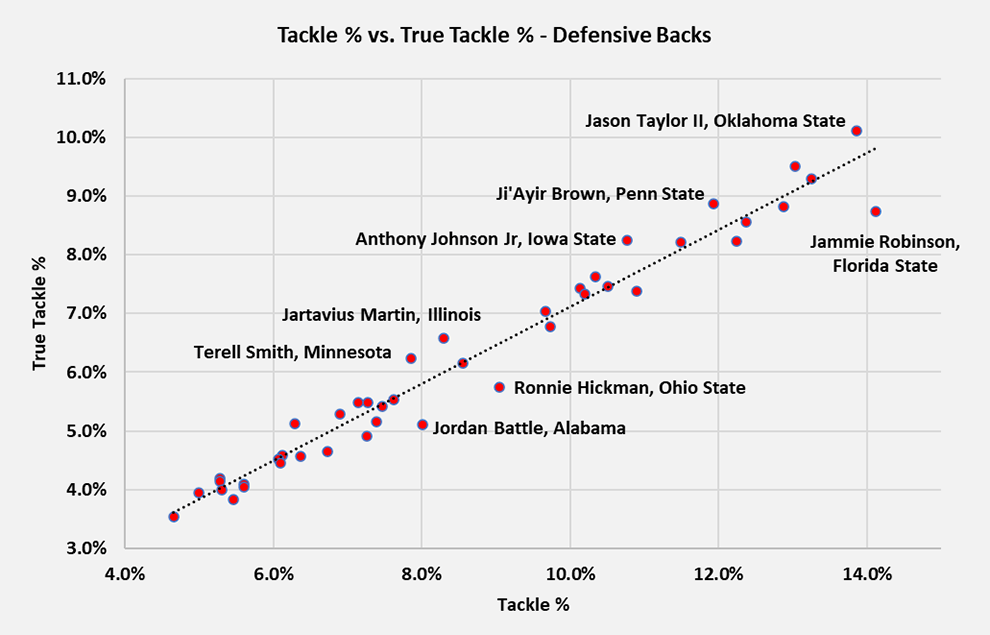
Ji’Ayir Brown of Penn State is the second ranked safety in the class according to Scouts Inc, and True Tackle % also gives Brown a favorable rating relative to his baseline Tackle %. Jartavius Martin of Illinois also projects to be one of the first safeties off the board according to Scouts Inc, and he also falls above the trendline in the plot above.
Solo Tackle Success Rate (STS)
The next upgrade Hudl IQ has to offer is the introduction of Solo Tackle Success %, abbreviated as STS. When analyzing tackling performance among potential NFL Draft prospects, teams would likely want to know not only who made a lot of tackles when they were on the field (True Tackle %), but also how good each player was at converting their solo tackle attempts - those in which another player was not already in the process of tackling the ball carrier.
Thus, STS is the % of each player’s solo tackle attempts that are converted to a tackle, with solo tackles getting full credit and assisted tackles getting credit for 0.5 tackle. This is synonymous with the spirit of True Tackle %, giving fair credit to those tackles that were made without additional help from teammates. Because this is Solo Tackle Success, assisted tackle attempts and any subsequent tackles made on those plays are not considered. Solo Tackle Success is purely analyzing the outcome of solo tackle attempts in which the defender had the opportunity to make a solo tackle.
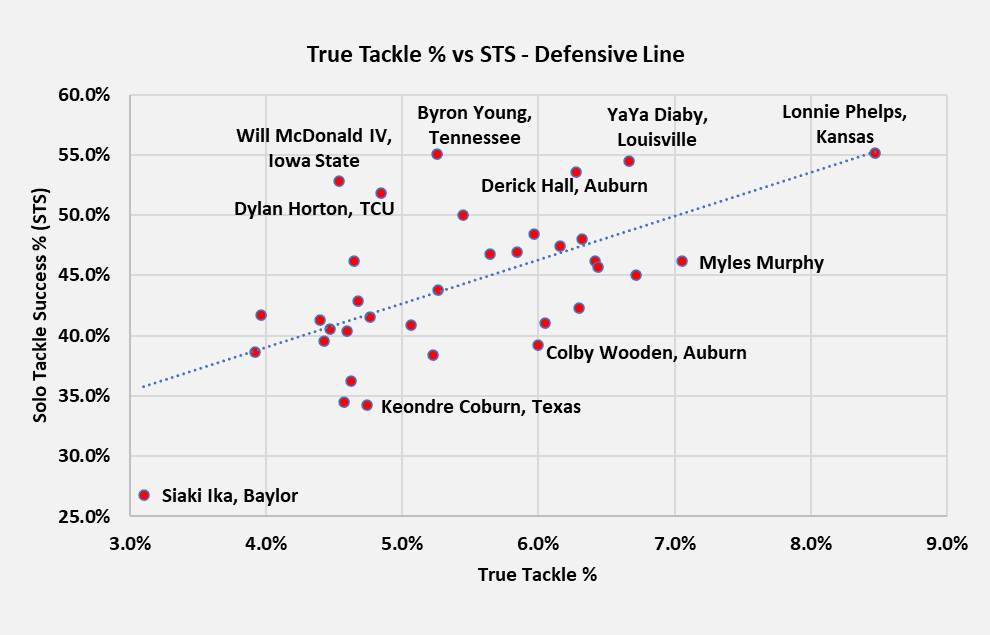
Looking at the plot above showing True Tackle % against Solo Tackle Success % (STS), we see a few names that also popped on the prior D-line visualization as players potentially overlooked by traditional Tackle % - YaYa Diaby , Derrick Hall, and Byron Young also rate out as highly effective tacklers on their solo tackle attempts, in addition to being defensive linemen that get as many, if not more, tackles than most of their D-line counterparts.
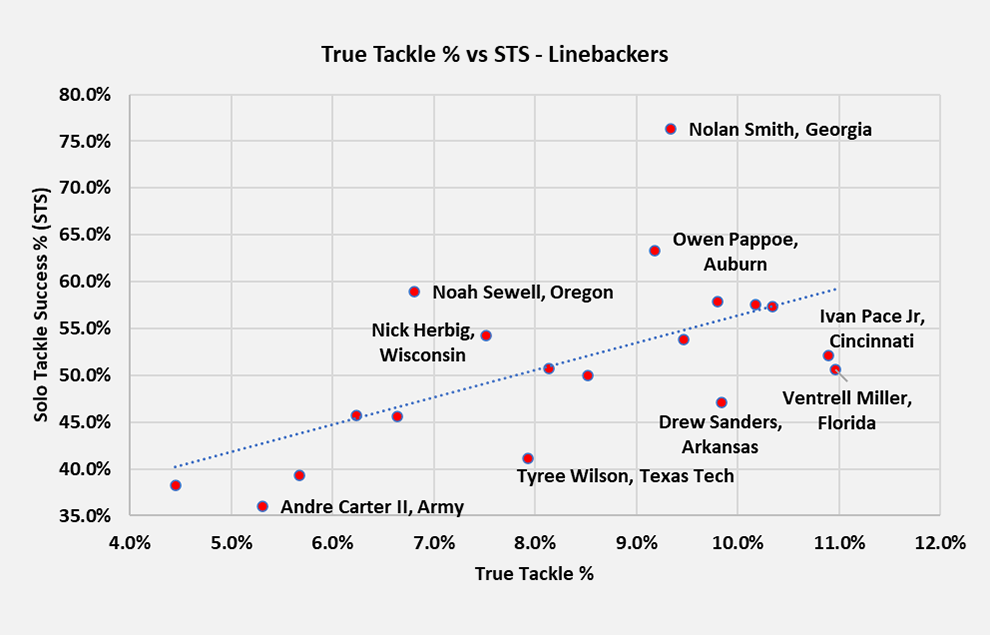
Whether plotted on the Defensive Line or the Linebacker chart, Nolan Smith’s Solo Tackle Success % really stands far above the rest of his peers (again, over a much smaller sample of plays than other prospects). Highly touted prospect Tyree Wilson shows up as not having converted very many of his solo tackle attempts for solo tackles, though this likely isn’t a huge concern for most NFL scouts given his projected pass rushing ability and the lack of impact tackling has on sacking the QB.
A suspect STS could be more concerning from a scout’s perspective for players like Ivan Pace Jr. and Drew Sanders, who project to play more off-the-ball LB in the NFL while players like Nolan Smith and Tyree Wilson are much more likely to be aligned along the Edge of the defensive front.
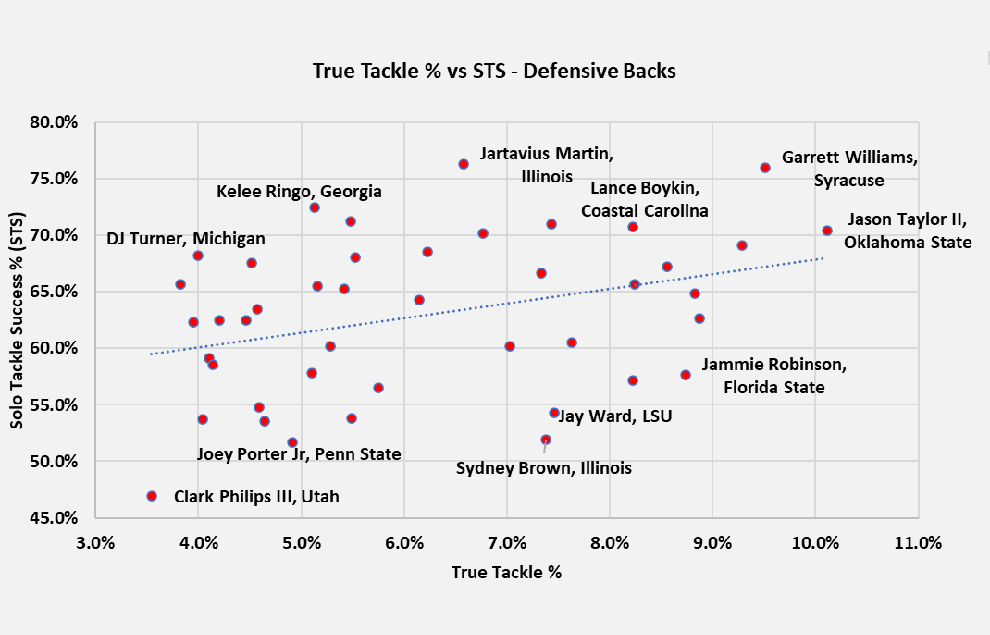
Acute observers may notice the much flatter trendline we see on the same plot for Defensive Backs, which would appear to indicate that there doesn’t appear to be nearly as strong of a relationship between True Tackle % and STS for defensive backs as there is for defensive linemen and linebackers, which could be cause for a separate piece of analysis that considers how tackling varies among defensive positions.
Among the highest rated defensive backs via Scouts Inc, Jartavius Martin of Illinois really stands out as an effective solo tackler, and he was also on the right side of the earlier Tackle % trendline. Martin’s teammate, Sydney Brown, finds himself on the opposite side of the chart, indicating Brown wasn’t nearly as good as converting on his solo tackles attempts. Garrett Williams of Syracuse is another player that really pops on this chart, ranking second among all DBs in both True Tackle % and STS.
The introduction of True Tackles, True Tackle %, and Solo Tackle Success (STS) improve upon the longstanding and stale metrics related to tackling and will aid in laying the foundation for the rest of Hudl IQ's development of tackling related metrics.
